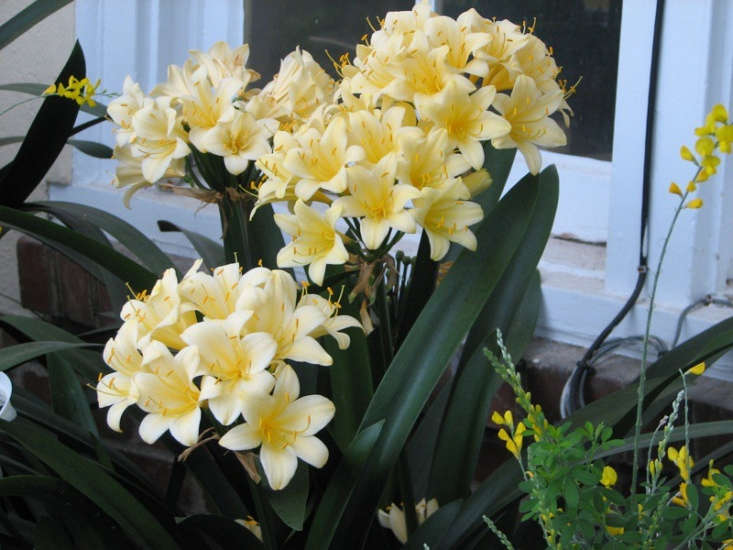Clivia
I was already a huge fan of Clivia—a durable and gorgeous shade plant—but when I learned that there are Clivia clubs, Clivia collectors, serious Clivia breeders, Clivia symposiums (held at the Huntington Botanic Garden in Pasadena), and a book by Harold Koopowitz aptly titled Clivias, I felt validated. And even though I am not an official member of a Clivia club, my devotion grows, especially as I continually plant clusters of Clivia in my client’s shady gardens and marvel at their easy but bold beauty.
Ready to see if you want to join my unofficial Clivia fan club?

Native to South Africa and properly pronounced with a long “i”, this flowering plant has been around for a very long time. These unique plants received their genus name in 1828 by Kew botanist John Lindley who named the plant after Lady Charlotte Florentine Clive, Duchess of Northumberland, who is credited as being the first to cultivate the plant in England. Today, most Clivia breeding happens in Japan, China, and Korea where many selections and hybrids are being raised, and some of the focus is more on creating interesting foliage (think variegated) rather than just the flowers.
I am fortunate that I live in an area with mild winter temperatures so I can grow Clivias outdoors, but most people grow Clivias as houseplants or they grow them as outdoor container plants that are brought indoors for overwintering. In fact, these plants were very trendy as houseplants during the Victorian Era in Europe because of their fuss-free winter culture and preference for cooler indoor temperatures.

So, what’s the appeal? Well, it’s all about the stunning, long-lasting blooms that vary in color from yellow to bright orange to reddish and that start their show typically in mid to late winter and continue through early spring. After flowering, plants can produce showy fruit (which is often the same color as the flowers) if the flowers have been pollinated. As a member of the amaryllis family, this plant produces trumpet-like flowers in dense clusters on top of a thick, fleshy stem that arises from fans of glossy, strap-like evergreen leaves that arch over one another. A mature plant can be about 2 to 3 feet tall and wide.
Other attractive features of Clivia is that they are also fairly drought-tolerant due to their thick, fleshy roots that store water; plus these toughies can tolerate a fair amount of neglect. Clivia‘s active growing period is from spring through fall, and then following an important rest period, where way less water is given, clivias usually begin blooming around February. This rest period is important so that the plant won’t continue putting out foliage but instead work on setting flower buds. The other big requirement if you live in cold regions? You must bring them inside your house or move them to a protected greenhouse before freezing weather hits. After the last threat of frost has passed, you can bring them back outside and resume normal watering and fertilizing monthly with half-strength solution.
Popular Selections

Clivia caulescens
This plant has floppy leaves and produces pendant, funnel-shaped, pale red flowers with yellow stamens. Typically growing to 2 to 3 feet tall, it is different than other Clivias because of its thick stalk, up to 3 feet long, giving this plant its common name: Stalked Clivia.
Clivia miniata
Sold less often in stores but commonly traded among gardeners, this variety has thin (1- to 1 1/2-inch wide) leaves and pale orange flowers.
Clivia nobilis
Producing long-blooming, tubular orange flowers that droop, this 1 to 2 foot tall plant forms clumps of dark green evergreen strappy leaves.
Cheat Sheet

- A lovely alternative to other winter-blooming plants such as amaryllis, azaleas, and holiday cactus.
- The flowers and the showy fruit can be cut and used in arrangements.
- Looks perfect in a woodland, zen, or tropical garden. Also, the variety Clivia miniata is a very drought-resistant plant that is a smart choice for under oak trees in coastal California.
- Perfect alone in pots or massed together in the ground for a bolder effect.
- Like amaryllis, Clivia is poisonous because it contains alkaloid lycorine, but large amounts must be ingested to cause toxicity.
Keep It Alive

- Indoors, Clivias prefer bright, indirect light, while those planted outdoors need a shady and a fairly frost-free area (hardy only in zones 9 and 10).
- Wherever you plant them, they need rich, well-draining soil. Root rot can occur with overwatering and wet conditions.
- They are not huge fans of having their roots disturbed but repotting can happen every five years in the spring once the flowers have faded. But know that they bloom better when their roots are a bit congested.
- Propagation is a little tricky so root division is the preferred method.
- Few pests will bother them—even deer leave them alon—but mealybugs like to hide in the tight spaces between the leaves.
For similar plants, see:








Have a Question or Comment About This Post?
Join the conversation